Editor's Note: A version of this post originally appeared on the Unbounce blog earlier this month.
"Learn to code." This honorable slogan has become the focal point of campaigns targeted at students, new graduates and job seekers alike. It’s received plenty of praise and its fair amount of flack, too.
Now the slogan is increasingly targeted at another group: marketers.
"Technical skills are becoming a requirement for success in online marketing," Jamie Steven, former chief marketing officer at Moz now chief marketing officer at Ookla, wrote in a convincing blog post on the Moz blog last year. "It seems like the general consensus in the marketing world is that those who don’t keep up with new technologies and learn how to leverage them will be left behind," Buffer’s Belle Beth Cooper summarized the trend earlier this month.
All while this conversation is taking place, however, there’s a new crop of companies creating products for the marketer who’s zeroed in on increasing their company’s conversion rates instead of their own coding proficiency.
"We’re in the midst of marketing’s technical liberation when technology enables marketing teams to act directly, immediately and effectively," Redpoint Ventures’ Tomasz Tunguz wrote in August. "Technology is abstracting away many of the interactions between marketing and the other teams in a startup. This trend increases the influence and effectiveness of startup marketing teams."
While technology isn’t removing all interactions between marketers and developers—and that’s not a bad thing—here are 15 tools that give marketers 90-percent control over their own conversion rate optimization destiny:
1. Optimizely
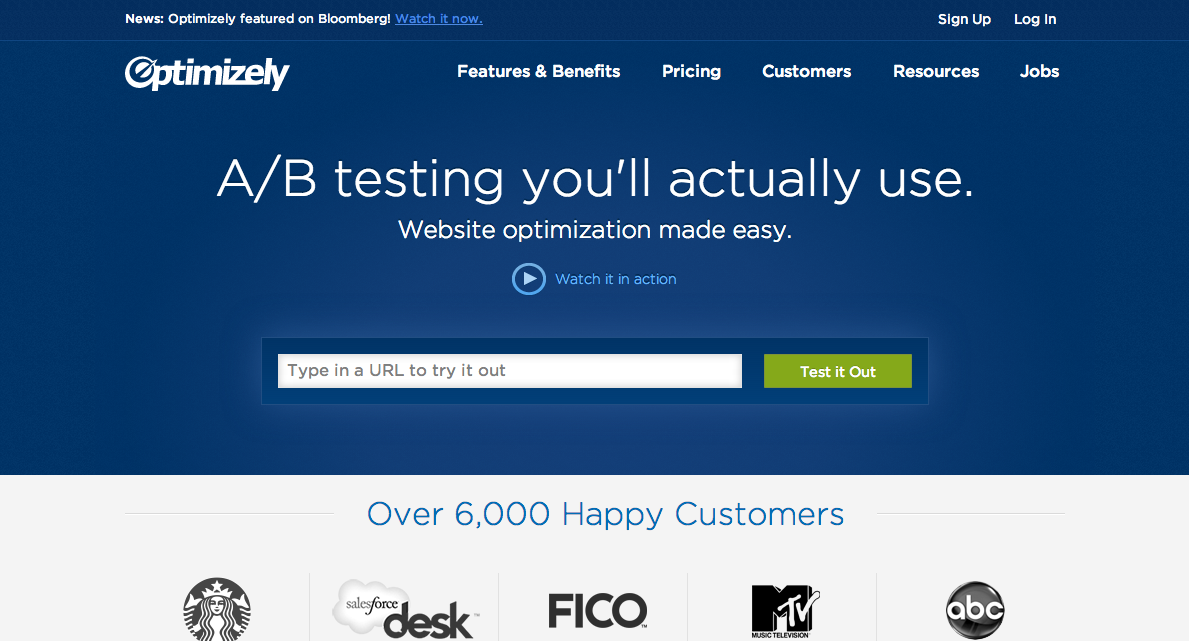
Optimizely gives you the power to change the look of a page with a few clicks, and then deploy the new layout to A/B test it against your site’s current design. You can also set and track goals, and if you find a winning new design, deploy it as the main site until your team’s developers have the time to fully program it.
Proof Point: "Dwolla is able to quickly test elements in a way that doesn't disrupt our user experience or internal developer resources," Jordan Lampe, the payment company’s communications director, said in an email interview. "Whether your goal is to increase conversion, improve a product, or learn about your customer, this is a must-have tool that you just have to see to believe.
Tech Involvement: To begin using Optimizely, a developer must add a small snippet of code to the page their marketing colleague is going to test. And for that, the company offers a tutorial video.
Similar: Convert.com and VWO
2. Vero

Vero lets you track customers on your website and send emails based off actions. If a trial user, for example, makes it though all but the final step of upgrading to a paid account, you can automate the sending of an email two days later to address any possible reservations and hopefully get them buying your product.
Proof Point: "Previously, changes to emails were addressed infrequently because the creative needed to be created, then coded in PHP in order for them to be shipped," Bridge Mellichamp, director of marketing operations at inventory management software maker Stitch Labs, said in an email interview. "Now, we make changes on a weekly, if not daily, basis, so that email can be a key component to support our broader initiatives." One such series of alterations led to a 5x increase in customer one-on-one calls with "Set-up Specialists," a step Stitch identified as key in their onboarding process.
Tech Involvement: Vero provides a step-by-step guide to adding their JavaScript library to your site, which allows their product to identify your customers and specified trigger actions. (It’s doc even gives you the instructions to "send the setup code to a developer on your team.")
Similar: Intercom.io, UserFox and Customer.io
3. Unbounce
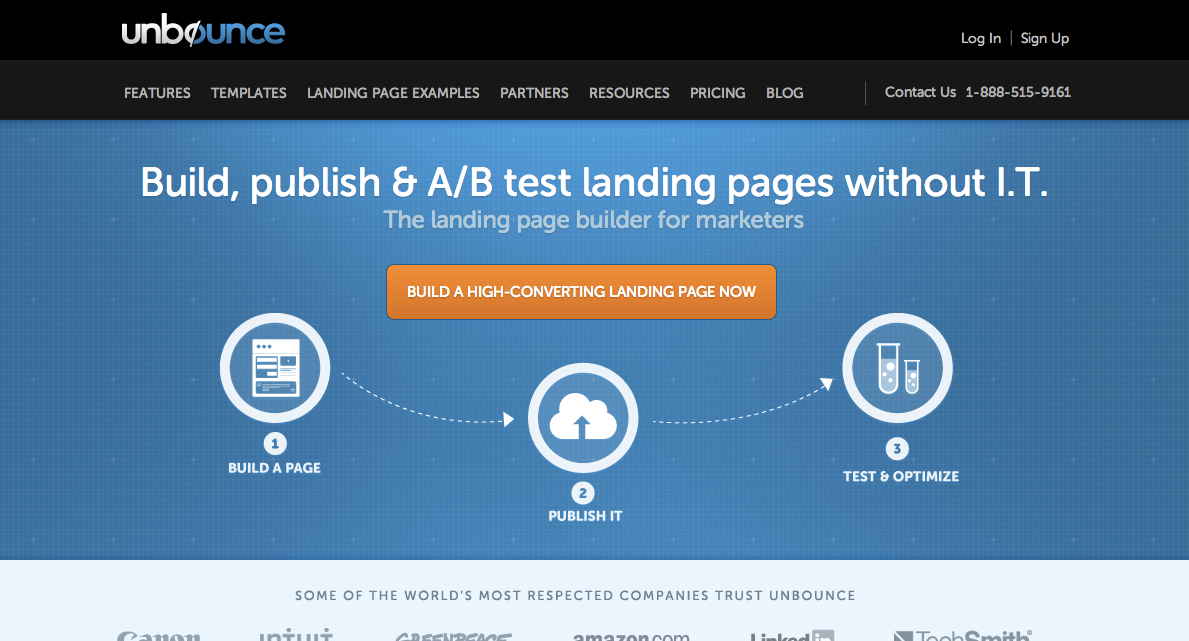
Unbounce makes it super easy to launch a landing page. It gives you a library of templates designed for conversion, and an editor to customize it to your brand. The use cases for the app are varied, such as a webinar signup page, product release promotion or ebook marketing, and it also offers the ability to A/B test your designs.
Proof Point: "I think the beautiful thing about Unbounce for us is the most non-technical people at our company master it very quickly," John Kim, founder of customer support app Doctorbase, said in an Unbounce case study. Kim’s team used the product to rebuild and A/B test their sign-up form for doctors, which led them to remove unnecessary fields. After implementing the new form, they experienced a 30 percent lift in new doctors.
Tech Involvement: To push your landing page live, you’ll need administrative access to your domain’s DNS, a responsibility often left to your tech colleagues. Though Unbounce offers an alternative: purchase a new domain name. "Zero technical knowledge required," Unbounce boasts. If you want to add your own web fonts or Google Analytics tracking, however, you’ll need to add CSS or JavaScript in the landing page editor.
Similar: Lander, KickoffLabs and Instapage
4. Kissmetrics
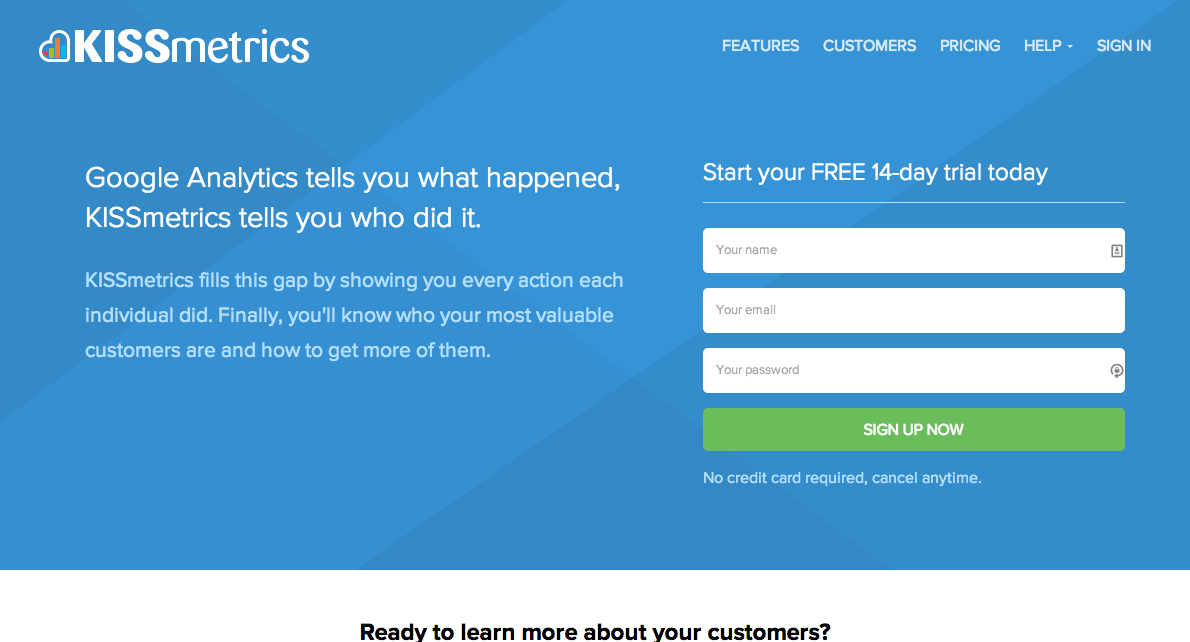
Kissmetrics lifts the lid off the way customers use your product. What used to take a deep dive into server logs, Kissmetrics offers with the familiar user experience of other analytics tools to, for example, show you the path your typical customer takes to make a purchasing decision or the steps taken by group of customers to set up their account. The app is especially potent for understanding your marketing funnel, including analytics on A/B testing.
Proof Point: LiveChat tracked individual customers to learn the path they took to purchasing their product. Doing so, they discovered which page they were most likely to loose people, so they modified that page and adjusted their signup flow. The change resulted in an 18 percent increase increase in their customer signup rate, a Kissmetrics case study highlighted.
Tech Involvement: To start using Kissmetrics you’ll need to identify every page on which you want to track customers and then have your tech team add JavaScript to each of those pages. Kissmetrics offers a how-to on this step.
Similar: Mixpanel
5. Zapier
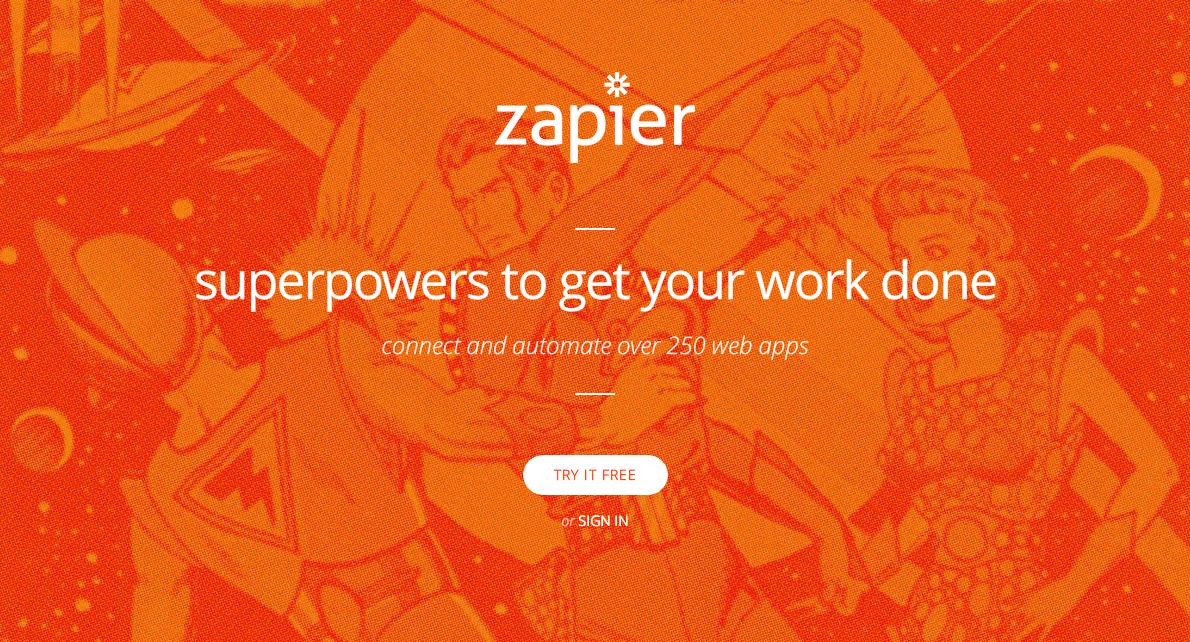
Zapier is an app automation platform that connects over 750 business applications, such as MailChimp, Wufoo, Box and GoToWebinar. In other words, Zapier gets your business apps talking to one another, automatically moving the data that you might otherwise take time copying and pasting between web services.
Proof Point: Taking the best of two apps can return big results. Using Unbounce to create the sign-up page, GoToWebinar to run the webinar and Zapier as the platform that connects the two web services, KISSmetrics increased its webinar signup rate by 1,000 percent.
Tech Involvement: Zip.
6. Crazy Egg
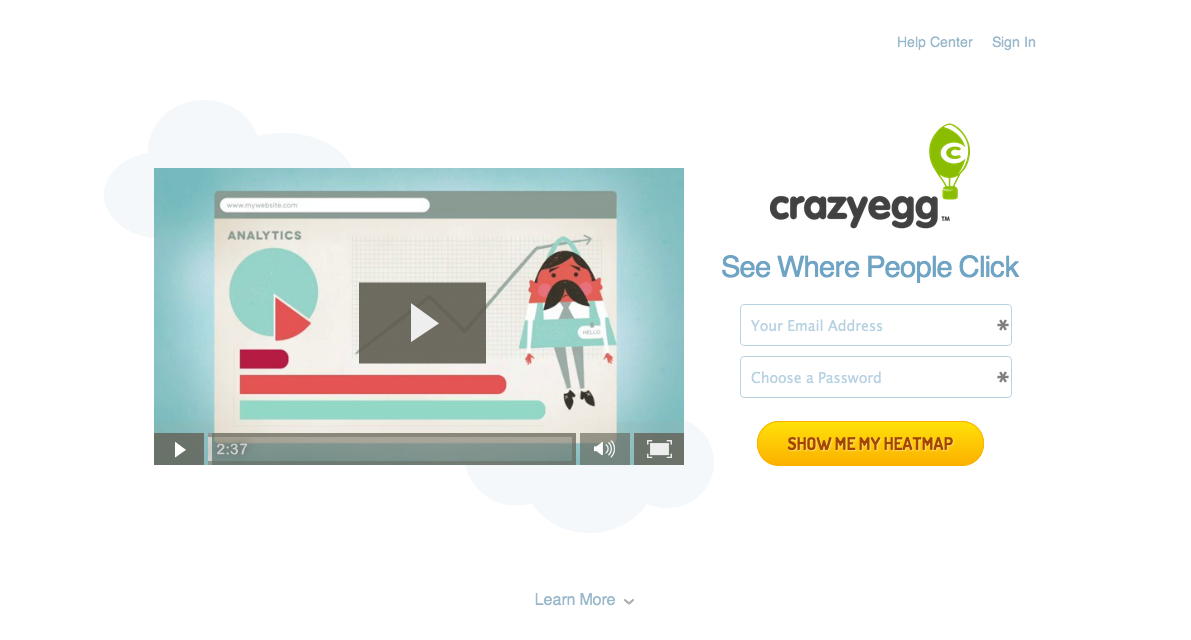
Crazy Egg provides four straightforward user stats in a visual manner: overall clicks, clicks attached to a referral source, clicks associated with a site element and what sections of a page were viewed by visitors. With these stats, it delivers on its slogan, "See where people click."
Proof Point: By utilizing Crazy Egg’s heatmap tool, online rental company Only-apartments was able to increase conversions by 9.4 percent. "We quickly detected a technical problem that caused all apartments to show that they don’t have bedding available, which directly affected our conversions in the case that bedding indeed was available," Maike Mocikat, an online marketer at Only-apartments, said in a case study provided by Crazy Egg.
Tech Involvement: To get started, you need to add a Crazy Egg tracking code to the web pages you’re going to test, a step that will require a technical co-worker.
7. Qualaroo
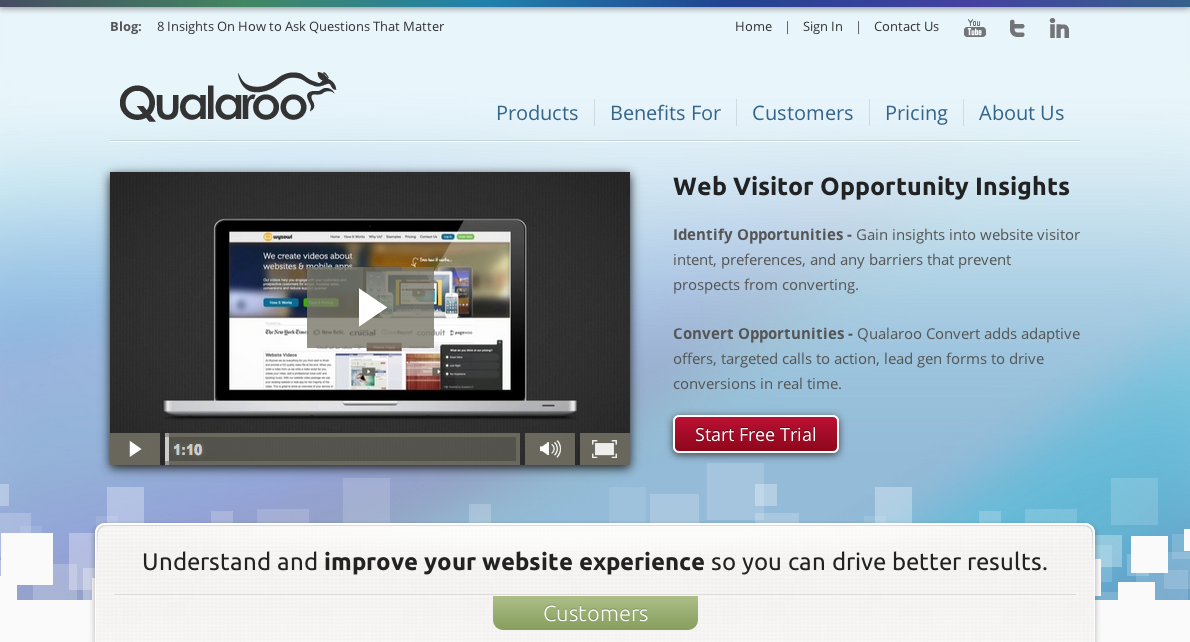
Qualaroo might sound like the simplest tool on this list but it’s shown it can result in some serious conversion rate increases. The app allows you to quickly add, edit and analyze answers to questionnaires delivered to your site visitors via a small box in the lower right-hand corner of the screen. It breaks down its tool to two use cases: identify or convert site visitors.
Proof Point: The University of Alberta increased its daily news email subscriber base by nearly 500 percent in less than a year. "We decided that after a reader visited a story and stayed on the page for 10 seconds, we would have a nudge pop up saying, ‘You seem interested in UAlberta news. Would you like to sign up for the Daily News email?’ Web content editor Jason Buzzell described the university’s use of Qualaroo in a guest post on the KISSmetrics blog.
Tech Involvement: To add a survey, a few lines of JavaScript are required on the page where you’ll want it present. The company offers a tutorial video and promises installation can be done in "under 2 minutes."
8. Typeform
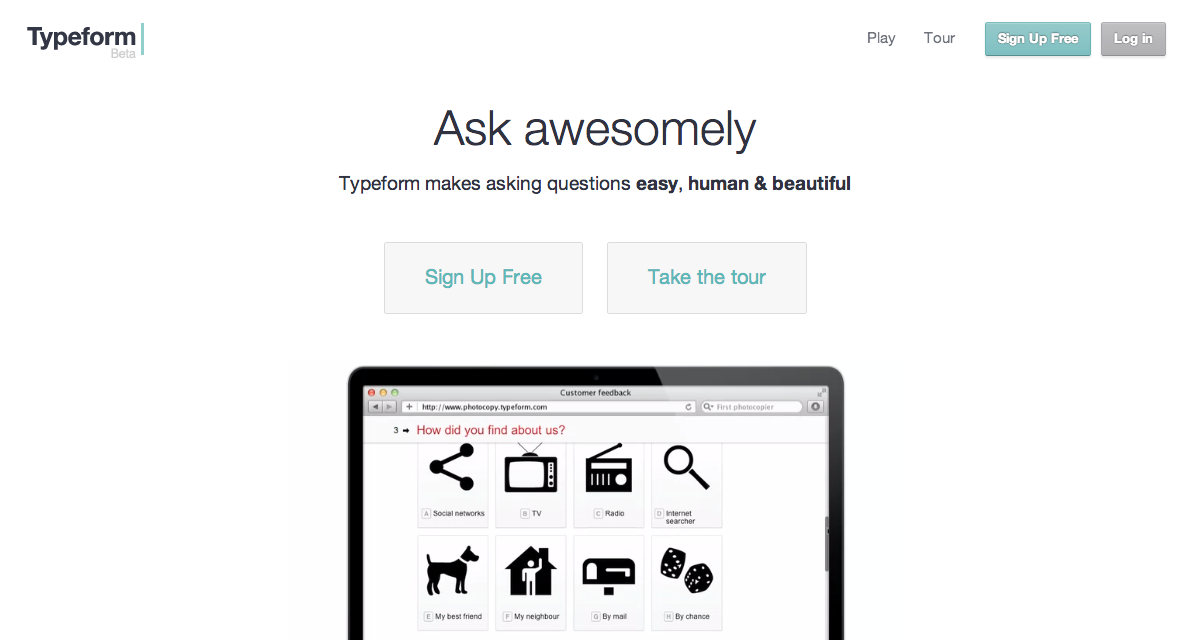
Typeform is form software. Nothing new, right? Somehow they made it so, taking a unique approach to how you experience a survey, questionnaire or sign-up process. The tool allows for heavy use of media (photos, icons and video) and customization of overall look and feel, which could come in handy for a marketing department wanting to stay true to its brand.
Proof Point: Still a young product without case studies to its name, one notable use case has been by Leica Camera, who employed TypeForm to collect names of visitors to its kiosk at a convention in Melbourne. "Typeform provides an online application to build the coolest forms," the developer behind the registration app said on his blog.
Tech Involvement: If embedding in a blog post, it’s as easy as any other form software tool. If embedding elsewhere on your site, you’ll likely need to consult a tech teammate.
9. Olark
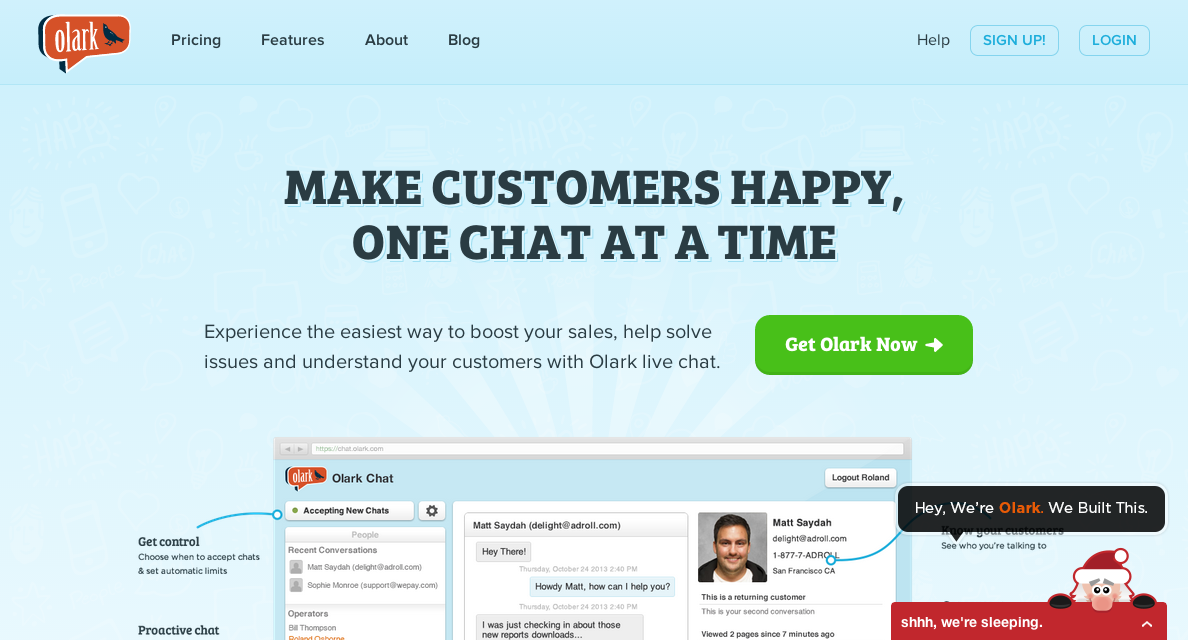
Olark isn’t software to deploy your next marketing campaign but it could help you plan it. It allows your customers to instantly chat with you or another company rep, giving you an opportunity to learn what they’re looking for on your site and how you can tailor your marketing to better serve that up in the future. It could also be another channel to collect marketing qualified leads as you can ask the visitor to provide their email address in a pre-chat survey.
Proof Point: "Live chat is a great tool, but it doesn’t end when chats are closed,"creative firm owner Claire Broadley said in a post on the Olark blog. "Remember how I said you should collect email addresses? Here’s another reason why: by collecting the visitor’s email address, you can refer back to the transcript and follow up your chat with a focused, friendly email."
Tech Involvement: Olark works by embedding a small piece of provided JavaScript on your website, which will likely require the help of your tech team.
Similar: LiveChat and SnapEngage
10. Geckoboard
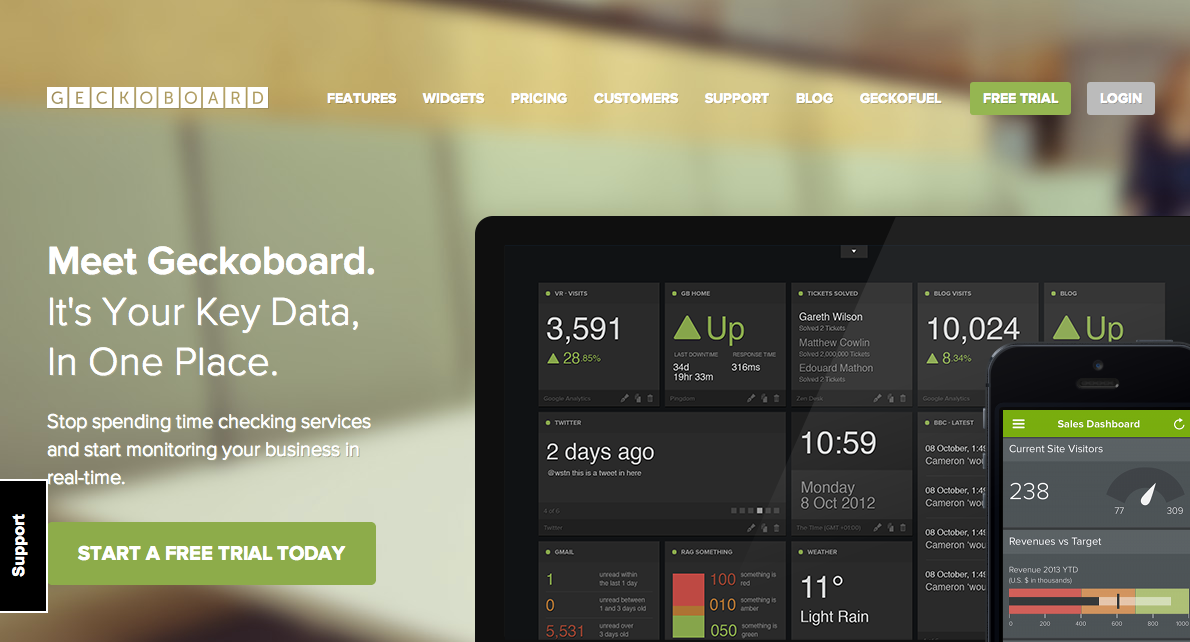
Geckoboard lets you create a real-time dashboard to show you the numbers that matter, be it social stats, page visits or video plays. The app pulls in data from 60+ web services, including Google Analytics, Pinterest, Twitter and Facebook.
Proof Point: "We love it here at SEOmoz, and have two big screens up in our office," former Moz chief marketing office Jamie Steven told Geckoboard. "We created a 'Marketing Dashboard' that really focused on one big number—free trials per day." Steven said engineers and support team members will walk by the screens and make comments about how their company’s performance. "It's created an excitement in the office," he said.
Tech Involvement: You’re able to choose from a long list of ready-made "widgets," but if you want to create a custom widget like Moz, a developer’s hand will be needed.
11. HubSpot
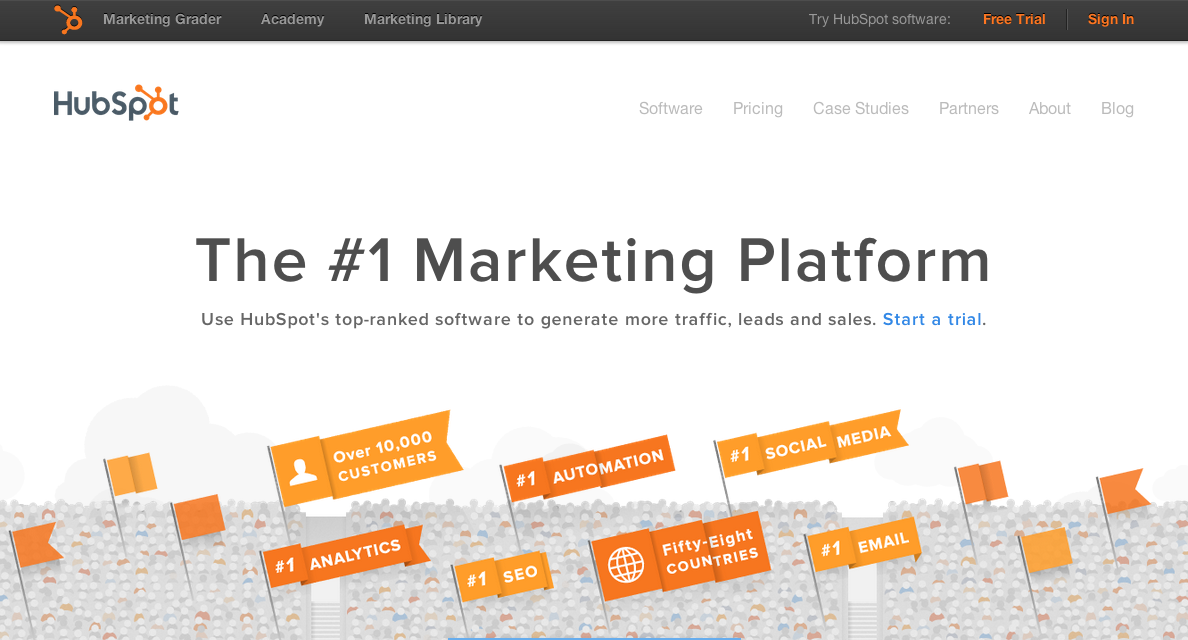
HubSpot is more than a tool, it’s a platform, and it must feel like a giant on this list compared to some of the more up-and-coming apps. The reason it’s here though is because of its arsenal of inbound marketing tools for non-tech users, such as a content management system, social media monitoring app, web and landing page creator and form builder.
Proof Point: Hy-Line Cruises used HubSpot’s Marketing Automation tool, Workflows, to follow up with website visitors who downloaded an "Insider’s Guide." Compared to the year before when they weren’t using any kind of lead nurturing to promote these offers, according to a HubSpot case study, Hy-Line sold 17x more Fall Daytrip Specials to Martha’s Vineyard and 5x more cruise offers to Nantucket.
Tech Involvement: With HubSpots wide offering, it’ll depend on what you’re using if your tech team needs to spend time implementing it. For this, the company offers a detailed getting started guide.
Similar: Pardot
12. Gumroad
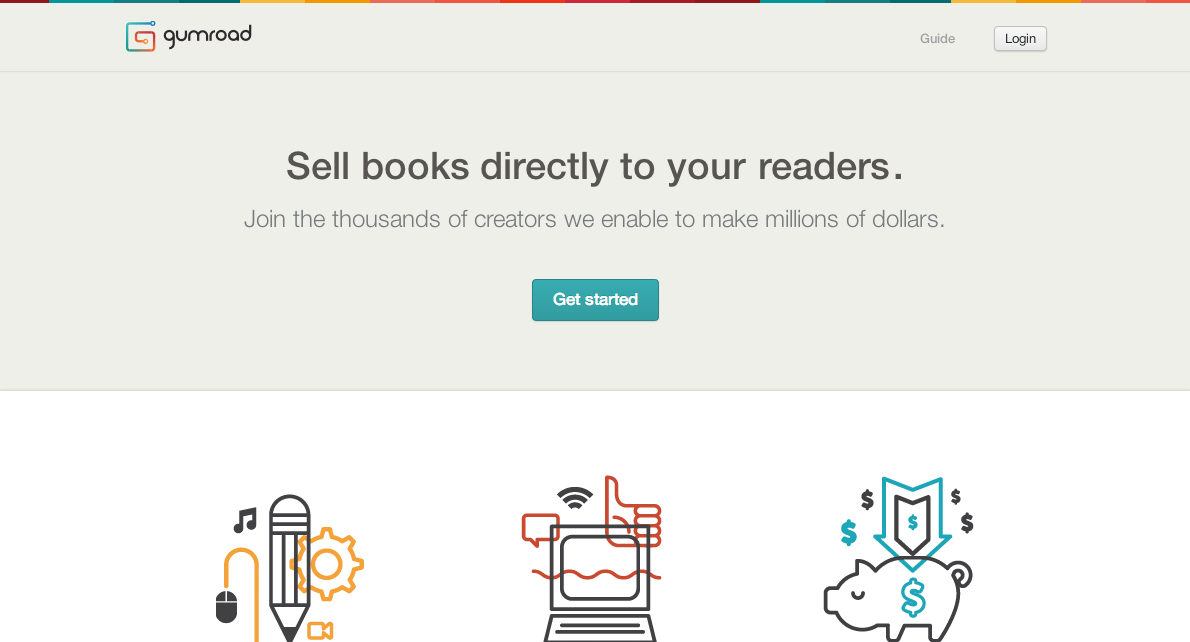
Gumroad is a simple ecommerce platform to distribute digital goods. You don’t need to charge anything for an item, but instead, you can collect an email to let someone download your ebook, podcast or video. Or you can go farther, collecting information that would help you identify the purchaser as a marketing qualified lead. The product is generally geared towards artist, musicians and other makers, but it could be a great marketer’s tool, too.
Proof Point: "By removing all the hurdles you typically associate with online commerce: account creation, shopping carts, billing address, all that stuff, we create a much more fluid transaction," a Gumroad team member told The Verge in an article highlighting Girl Talk’s use of the platform.
Tech Involvement: Nothing. Unless you embed the item on your site, then you’ll need to call your tech teammate to add it where you’d like.
13. Open Site Explorer
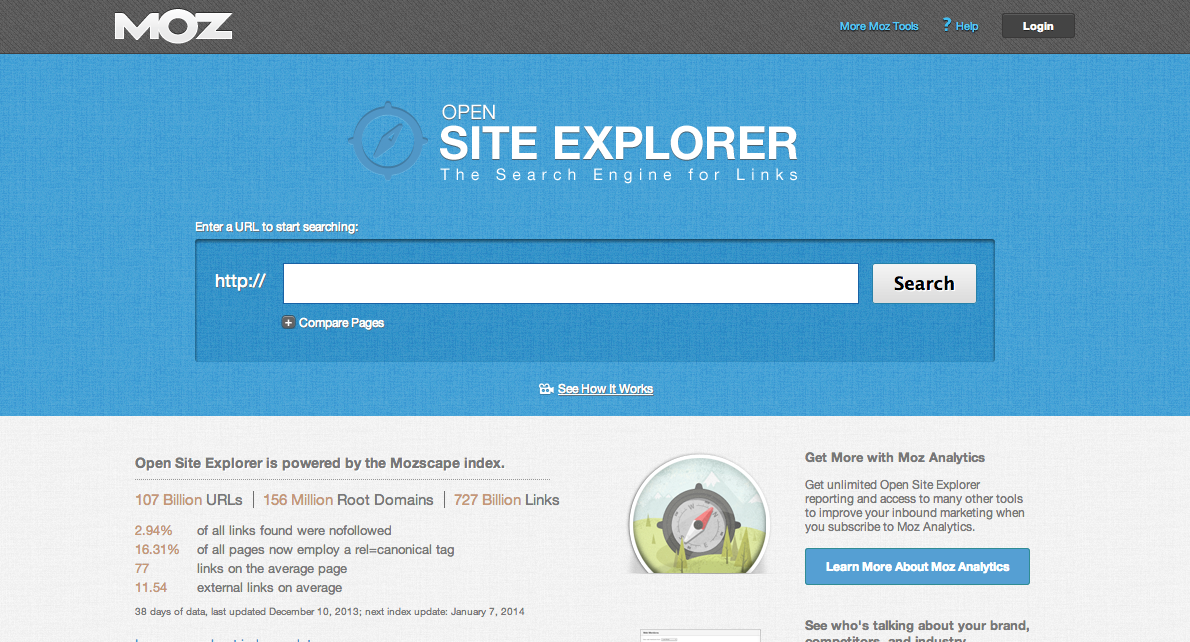
Open Site Explorer from Moz provides quick access to social sharing data, such as Facebook and Twitter shares. It also tracks back links from other sites, a task that’s tedious for a developer.
Proof Point: Using Open Site Explorer, I found that Unbounce blog listicles showing off tools had a high number of social shares, which led me to pitch and earn the chance to write a guest post for their site. As of today, the post has over 500 shares across Twitter, Facebook, Google+ and LinkedIn.
Tech Involvement: Zero.
14. Balsamiq
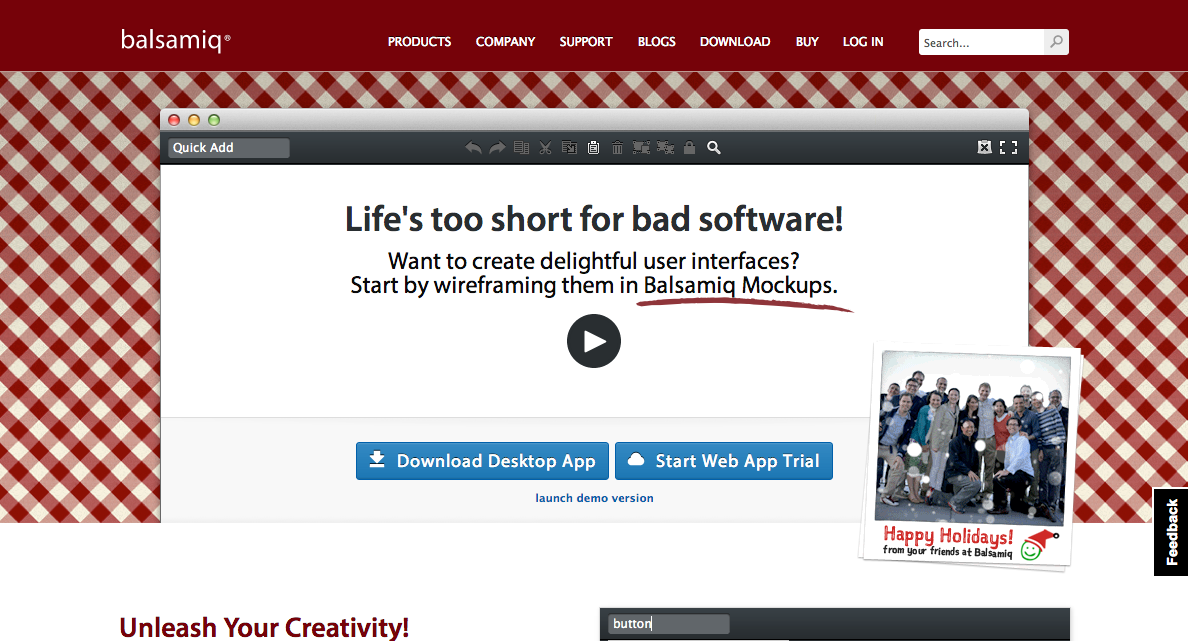
Balsamiq is a rapid wireframing tool that reproduces the experience of sketching on a whiteboard, but using a computer. Though you might not think this fits in your marketing responsibilities, this simple software comes in handy to when you’re writing copy for a re-design or participating in the actual re-design itself.
Proof Point: "As a minimum, use Balsamiq when writing your home page copy. Ideally, use it to write other pages too, and link them together in interactive PDFs for client review," Glenn Murray, a professional copywriter said in an interview with Balsamiq.
Tech Involvement: Nada.
15. Technical Mktg

Ah! You didn’t expect this one, did you? The above tools give you plenty of power to take your marketing campaigns one step further, but if there’s one takeaway I learned from assembling this list it’s that learning to code at even a beginner’s level will bring many benefits.
"Perhaps my favorite reason to develop these skills is the ability to communicate better with everyone in your organization," Steven wrote on the Moz blog. "If you know what's possible, then you'll know what to ask for when you work with developers, designers, and analysts. And in many cases, you'll be able to just do the work yourself."
If you want to take this next step, Steven has put together a great place to start on his site Technical Marketing.
When published on the Unbounce blog, readers suggested analytics platform Segment.io, data analysis app Chart.io and content marketing tool Uberflip.
What tool would you recommend to a non-tech marketer? One where they have at least 90 percent of the control.





